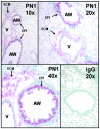The SERPINE2 gene is associated with chronic obstructive pulmonary disease
- PMID: 16358219
- PMCID: PMC1380249
- DOI: 10.1086/499828
The SERPINE2 gene is associated with chronic obstructive pulmonary disease
Abstract
Chronic obstructive pulmonary disease (COPD) is a complex human disease likely influenced by multiple genes, cigarette smoking, and gene-by-smoking interactions, but only severe alpha 1-antitrypsin deficiency is a proven genetic risk factor for COPD. Prior linkage analyses in the Boston Early-Onset COPD Study have demonstrated significant linkage to a key intermediate phenotype of COPD on chromosome 2q. We integrated results from murine lung development and human COPD gene-expression microarray studies with human COPD linkage results on chromosome 2q to prioritize candidate-gene selection, thus identifying SERPINE2 as a positional candidate susceptibility gene for COPD. Immunohistochemistry demonstrated expression of serpine2 protein in mouse and human adult lung tissue. In family-based association testing of 127 severe, early-onset COPD pedigrees from the Boston Early-Onset COPD Study, we observed significant association with COPD phenotypes and 18 single-nucleotide polymorphisms (SNPs) in the SERPINE2 gene. Association of five of these SNPs with COPD was replicated in a case-control analysis, with cases from the National Emphysema Treatment Trial and controls from the Normative Aging Study. Family-based and case-control haplotype analyses supported similar regions of association within the SERPINE2 gene. When significantly associated SNPs in these haplotypic regions were included as covariates in linkage models, LOD score attenuation was observed most markedly in a smokers-only linkage model (LOD 4.41, attenuated to 1.74). After the integration of murine and human microarray data to inform candidate-gene selection, we observed significant family-based association and independent replication of association in a case-control study, suggesting that SERPINE2 is a COPD-susceptibility gene and is likely influenced by gene-by-smoking interaction.
Figures




Comment in
-
The SERPINE2 gene and chronic obstructive pulmonary disease.Am J Hum Genet. 2006 Jul;79(1):184-6; author reply 186-7. doi: 10.1086/505268. Am J Hum Genet. 2006. PMID: 16773582 Free PMC article. No abstract available.
References
Web Resources
-
- Bioconductor, http://www.bioconductor.org/
-
- C.L. Web site, http://biosun1.harvard.edu/~clange/pbat.htm (for PBAT)
-
- GenBank, http://www.ncbi.nlm.nih.gov/Genbank/ (for SERPINE2 [accession number NM_006216])
-
- Lung Transcriptome, http://lungtranscriptome.bwh.harvard.edu/
-
- Online Mendelian Inheritance in Man (OMIM), http://www.ncbi.nlm.gov/Omim/ (for COPD) - PubMed
References
-
- Alessandri C, Basili S, Violi F, Ferroni P, Gazzaniga PP, Cordova C, Chronic Obstructive Bronchitis and Haemostasis Group (1994) Hypercoagulability state in patients with chronic obstructive pulmonary disease. Thromb Haemost 72:343–346 - PubMed
-
- Ashitani J, Mukae H, Arimura Y, Matsukura S (2002) Elevated plasma procoagulant and fibrinolytic markers in patients with chronic obstructive pulmonary disease. Intern Med 41:181–185 - PubMed
Publication types
MeSH terms
Substances
Associated data
- Actions
Grants and funding
- R37 HL067204/HL/NHLBI NIH HHS/United States
- HL071885/HL/NHLBI NIH HHS/United States
- HL67204/HL/NHLBI NIH HHS/United States
- N01HR76101-N01HR7611/HR/NHLBI NIH HHS/United States
- R01 HL071393/HL/NHLBI NIH HHS/United States
- R01 HL075478/HL/NHLBI NIH HHS/United States
- N01 HR076101/HL/NHLBI NIH HHS/United States
- R01 HL054853/HL/NHLBI NIH HHS/United States
- HL075478/HL/NHLBI NIH HHS/United States
- N01 HR076119/HL/NHLBI NIH HHS/United States
- HL072918/HL/NHLBI NIH HHS/United States
- N01 HR076118/HL/NHLBI NIH HHS/United States
- R01 HL071771/HL/NHLBI NIH HHS/United States
- HL71771/HL/NHLBI NIH HHS/United States
- HL61575/HL/NHLBI NIH HHS/United States
- R01 HL071885/HL/NHLBI NIH HHS/United States
- N01 HR076116/HL/NHLBI NIH HHS/United States
- HL54853/HL/NHLBI NIH HHS/United States
- K08 HL072918/HL/NHLBI NIH HHS/United States
- HL71393/HL/NHLBI NIH HHS/United States
LinkOut - more resources
Full Text Sources
Other Literature Sources
Medical
Miscellaneous

